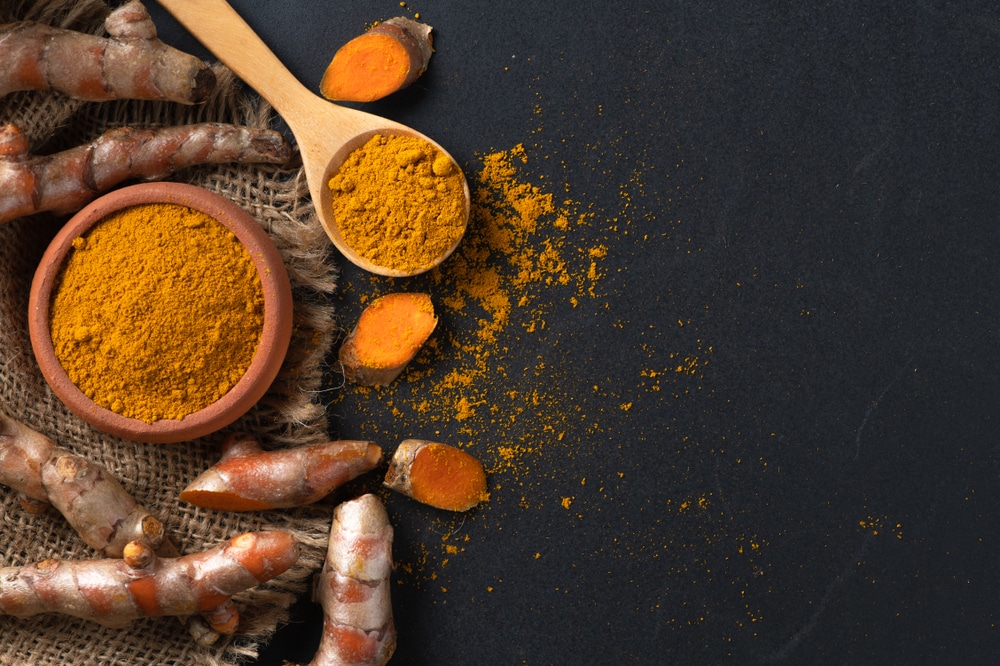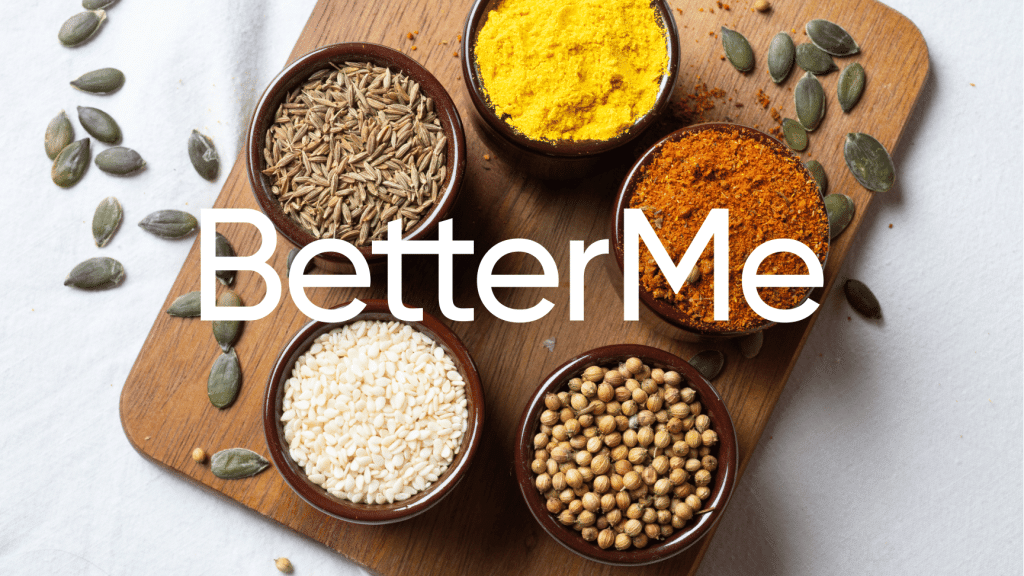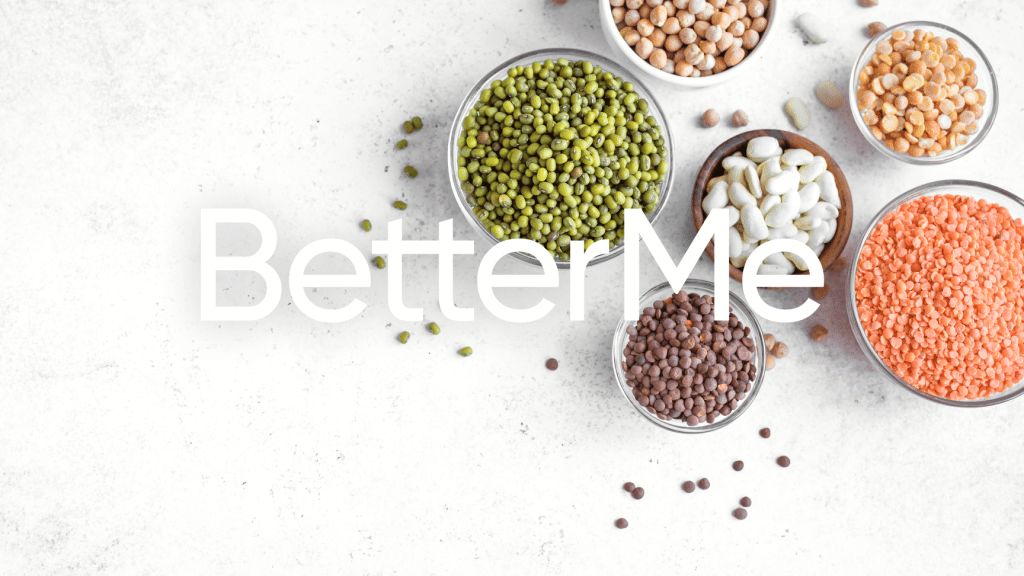Flavor and aroma aside, spices are one of the easiest ways to add a healthy boost to your culinary creations. From the familiar cinnamon and nutmeg to the more obscure achiote and grains of paradise, each spice offers its own unique flavor profile as well as potential health benefits. Cumin and turmeric are two popular spices that have become staples in many global cuisines. While they both add a distinctive flavor to dishes, they have a similarity that makes them confusing for the uninitiated. The names curcumin (the active compound in turmeric) and cumin are often used interchangeably, but the two spices have distinct differences. Here’s everything you need to know about cumin vs turmeric, including what makes them different, how to use them in cooking, and their potential health benefits.
Get your personalized
meal plan!
What Is Cumin?
Cumin is a flowering plant that is part of the parsley family (Apiaceae). It is an annual herbaceous plant native to Syria and Iran with small leaves, feathery foliage and purple or pink flowers. The seeds are small and brownish-black with an oblong shape.
Ground cumin powder can be found either dark or light colored depending on whether its seed was picked early or late in its growth cycle; darker colors tend to contain more volatile oils which make them spicier than their lighter counterparts.
Cumin has an earthy, nutty aroma with a hint of citrus and sweet spices. Its flavor profile is both warm and intense, with notes of pepper, cloves, and garlic. It imparts a smoky-woodsy taste which can be enhanced when it is toasted whole before grinding.
Cumin has been used in traditional cooking for centuries as a spice or condiment in dishes from North Africa, India, the Middle East, Latin America and other regions around the world. It forms an essential part of many curries and masalas (spice mixtures).
Curry powder often contains ground cumin seed as its base ingredient; it adds a wonderful flavor to rice dishes, lentil soups, stews, and chili. Cumin can be added to salads, marinades, and dressings for a touch of extra flavor in your cooking. It is even used in some desserts like churros and other Mexican sweet treats.
In addition to its culinary uses, cumin has long been regarded as having medicinal properties; it is believed to help promote digestion, boost immunity, and reduce inflammation (1).
Read More: Black Cumin Benefits And Side Effects
What Is Turmeric?
Turmeric is a tropical plant that is part of the ginger family (Zingiberaceae). It is native to Southeast Asia and India, where it has been used for centuries in Ayurvedic medicine. The root of the turmeric plant is dried and ground into a fine powder that ranges from yellowish-orange to deep red-orange in color.
Turmeric has an earthy, pungent aroma with notes of citrus, pepper and ginger. Its flavor profile is warm, bitter, and slightly astringent; its taste resembles mustard or horseradish more than it does cumin or coriander.
Turmeric can be found as both a fresh root and as a spice powder. The powder is more common, and it’s an essential ingredient in Indian cooking. It is often used to give curries their characteristic yellow color, as well as to add a unique flavor to soups, stews, sauces, and marinades.
Turmeric also has many medicinal properties; it is anti-inflammatory and antioxidant and is believed to help support the immune system. Curcuminoids, the active compounds found in turmeric root, are being studied for potential health benefits related to heart disease, cancer protection, arthritis relief, digestive aid and more (13).
What Is The Difference Between Cumin And Turmeric?
Below are the primary differences between cumin and turmeric:
- Botanical Origins: Cumin is from the parsley family (Apiaceae), whereas turmeric is from the ginger family (Zingiberaceae).
- Part of the Plant: Cumin is the seed of a flowering plant; turmeric is the root of a tropical plant.
- Color: Cumin can be light or dark in color, while turmeric powder ranges from yellowish-orange to deep red-orange.
- Taste: Cumin tastes nutty and earthy with warm undertones of sweetness, while turmeric has an earthy, pungent flavor with notes of mustard or horseradish.
- Active Ingredients: The active ingredients in cumin include volatile oils and other organic compounds (like cuminaldehyde); while the active ingredients in turmeric are curcuminoids.
Turmeric Vs Cumin: Similar Health Benefits
Cumin and turmeric share the following possible health benefits:
1. Turmeric And Cumin For Heart Health
Turmeric may be especially beneficial for the heart, as it contains high levels of curcumin, an antioxidant compound that helps reduce inflammation and protect against free radical damage. Curcumin is thought to help lower blood pressure, improve cholesterol levels and reduce the risk of stroke and other cardiac conditions (13).
Cumin has many compounds that can benefit the cardiovascular system such as antioxidants, minerals and essential fatty acids. It is believed that the combination of these compounds can help to lower triglyceride levels and reduce the risk of coronary heart disease and stroke (6). Furthermore, some studies have suggested that cumin may help to regulate blood sugar levels, which can be beneficial for overall heart health.
2. Turmeric And Cumin For Diabetes
Turmeric is being studied for its potential anti-diabetic properties; some studies have indicated that it may help reduce the risk of developing type 2 diabetes and improve the symptoms of those who already have it (2) (13).
Cumin has been studied for its potential benefits in controlling diabetes due to its ability to regulate blood sugar levels. A study published in 2015 found that cumin extract significantly reduced fasting glucose levels and improved other markers of diabetes control such as HbA1c, an important indicator of long-term glucose control (7).
3. Turmeric And Cumin For Digestive Health
Both turmeric and cumin can be beneficial for digestive health as they contain compounds that are believed to stimulate the production of stomach acid, which helps the body digest food more efficiently. Turmeric is also believed to be calming for the digestive system and may help reduce inflammation in the gut (8).
Cumin has been used as a traditional remedy for stomach upset and nausea due to its high concentration of essential oils. It is thought that these compounds can help soothe an upset stomach and promote digestion (5).
4. Turmeric And Cumin For Osteoarthritis
Turmeric is believed to be beneficial for those with osteoarthritis due to its anti-inflammatory effects (13). Studies have found that it can help reduce joint pain and stiffness associated with the condition, as well as improve physical function.
Cumin may also be helpful in relieving symptoms of osteoarthritis due to its ability to reduce inflammation. However, more research needs to be done to determine if cumin can provide significant relief from the condition.
If you wish to free yourself from all the extra pounds that have been weighting you down for way too long, start using the BetterMe app and overhaul your entire life!
5. Turmeric And Cumin For Weight Loss
Turmeric contains compounds that are thought to help reduce body fat and promote weight loss. Studies have found that it can help increase metabolism, which may lead to increased calorie burning (4). Additionally, its anti-inflammatory properties and other mechanisms may also be beneficial in this regard.
In one study, 72 overweight participants took a cumin and lime supplement or placebo and found that a high dose of cumin and lime had beneficial effects on their weight as well as several metabolic markers. While this was a small study, it suggests that cumin may be beneficial for weight loss (14).
That said, neither turmeric or cumin can spot-reduce body fat. To achieve significant weight loss, it is important to combine them with a healthy diet and regular physical activity.
6. Turmeric And Cumin Anti-Aging Benefits
Turmeric is known for its anti-aging properties due to its high concentration of antioxidants.
These compounds help fight free radical damage and reduce inflammation, both of which are key factors in the aging process.
Additionally, turmeric is thought to help improve skin elasticity and collagen production, both of which are important for maintaining a youthful appearance (15).
Cumin is also believed to be beneficial for anti-aging due to its antioxidant content. It may also have potential as a skin-whitening agent to help improve uneven skin tone (12).
7. Turmeric And Cumin Anti-Inflammatory Benefits
Turmeric and cumin are both believed to be beneficial for reducing inflammation due to their active ingredients. Turmeric contains curcumin, which is a powerful anti-inflammatory compound that has been studied for its potential to reduce inflammation in the body (3) (15).
Cumin also contains flavonoids that act as antioxidants and have anti-inflammatory activity.
What Is Healthier, Cumin Or Turmeric?
When it comes to comparing the health benefits of cumin and turmeric, both spices offer a number of potential benefits. Turmeric is especially known for its powerful anti-inflammatory properties, as well as its potential for reducing joint pain and stiffness associated with osteoarthritis. Additionally, it is believed to have anti-aging benefits and can help promote weight loss.
Meanwhile, cumin has also been studied for its potential benefits in weight management and inflammation reduction. Additionally, it may also be beneficial in promoting digestion and relieving symptoms of osteoarthritis.
Ultimately, both cumin and turmeric offer numerous potential health benefits, so it is difficult to say which one is healthier. The best way to reap the benefits of both is to incorporate them into your diet in a variety of ways.
Read More: Cardamom Vs Coriander: An In-Depth Comparison
Can You Use Cumin And Turmeric Interchangeably?
No. Although cumin and turmeric are not interchangeable in recipes as their flavor profiles are quite different. Cumin has an earthy flavor with hints of citrus, while turmeric has a more pungent, slightly bitter taste with notes of pepper and ginger.
Each spice has unique properties and can be used to enhance the flavor of certain dishes, so it’s important to use the right one for the right dish. That said, both spices can be used together in some recipes for added depth and complexity.
For example, a stew or curry may call for both cumin and turmeric, as the two flavors complement each other in dishes with multiple aromatic ingredients. A tea or a marinade may also use both spices for added flavor.
Recipes With Cumin And Turmeric
Below, we’ve compiled a few recipes that incorporate both cumin and turmeric:
Roasted Cauliflower With Cumin And Turmeric (10)
Cauliflower is a perfect low-carb vehicle for all sorts of spices, and roasting it in cumin and turmeric adds a depth of flavor to the dish. Think of it like a rice dish, but without the carbs. The result is a crunchy and flavorful cauliflower side dish with just enough heat to make it interesting.
Ingredients:
- 1 head cauliflower, divided into florets
- 1 tablespoon olive oil
- 2 teaspoons cumin
- 1 teaspoon turmeric
- ½ teaspoon chili powder
- 1 teaspoon salt
Instructions:
- Prepare the cauliflower by cutting into florets.
- Preheat the oven to 425°F (220°C).
- In a large bowl, combine the cauliflower florets with olive oil and spices.
- Spread the cauliflower on a baking sheet lined with parchment paper.
- Bake for 20 minutes or until golden brown and crispy, stirring occasionally.
- Serve warm.
Alternatively, make it cauliflower rice by using a box grater to grate the cauliflower into rice-sized pieces. Then, follow the following steps.
- Squeeze any excess water from the grated cauliflower.
- Heat a large skillet over medium heat and add 1 tablespoon of olive oil.
- Add the grated cauliflower and season with cumin, turmeric, chili powder, and salt.
- Cook for 8-10 minutes or until the cauliflower is tender and lightly browned, stirring occasionally.
- Serve warm.
Yanking yourself back in shape has never been so easy with our game-changing fitness app! Start transforming your life with BetterMe!
Roasted Carrots With Turmeric And Cumin (11)
Carrots are a healthy and versatile vegetable that can be used in a variety of dishes. Roasting them with turmeric and cumin adds an earthy, smoky flavor that pairs perfectly with the sweetness of the carrots.
Ingredients:
- 10 medium carrots, peeled
- 2 tablespoons extra virgin olive oil
- Salt and freshly ground pepper to taste
- 1 tablespoon fresh thyme leaves
- ½ teaspoon cumin seeds, lightly toasted
- ½ teaspoon coriander seeds, lightly toasted
- 2 tablespoons unsalted butter, at room temperature
- ½ teaspoon turmeric
- ½teaspoon pepper or mild chili powder
- 2 tablespoons chopped fresh mint
Instructions:
- Wash, peel, and trim the carrots and cut into 1-inch pieces.
- Preheat the oven to 400°F (200°C).
- Arrange the carrots in a single layer on a baking sheet lined with parchment paper and drizzle with olive oil.
- Season with salt and pepper and sprinkle the thyme leaves over the carrots.
- Roast for 20 minutes, or until the carrots are tender and lightly browned.
- Meanwhile, heat a small skillet over medium heat and add the cumin seeds and coriander seeds. Toast for 2-3 minutes, until lightly browned and fragrant.
- In a small bowl, combine the butter with the toasted spices, turmeric, and chili powder.
- When the carrots are done roasting, remove from oven and toss with the butter mixture until evenly coated.
- Sprinkle it with chopped mint and serve warm.
Lemon, Turmeric And Cumin Tea (9)
Your immunity will thank you for this comforting tea that combines the anti-inflammatory benefits of turmeric and cumin with the tangy citrus flavor of lemon. The recipe calls for fresh turmeric, but you can also use ground powder if that’s all you have on hand.
Ingredients:
- 1 tbsp lemon juice
- 1 tsp turmeric
- ½ tsp black pepper
- Half inch ginger root
- ½ tsp cumin seeds
Instructions:
- Bring two cups of water to a boil in a medium saucepan.
- Peel and grate the ginger root and add to the boiling water.
- Add the cumin seeds and turmeric, and reduce heat to low.
- Simmer for 8-10 minutes.
- Remove from heat and strain the tea into two cups, discarding the ginger and cumin seeds.
The Bottom Line
Turmeric and cumin are both beneficial spices that can help improve overall health. They contain compounds that may reduce inflammation, boost digestion, ease digestive discomfort, and improve skin health. Additionally, they may be beneficial for weight loss and anti-aging.
However, more research needs to be done to determine the effects of these two spices on various health conditions. Note that turmeric and cumin should not be used as a substitute for medical treatment. If you are experiencing any health issues, it is best to speak with your healthcare provider before adding these spices to your diet.
Remember that these spices are most effective when used in combination with a healthy diet and regular physical activity.
DISCLAIMER:
This article is intended for general informational purposes only and does not serve to address individual circumstances. It is not a substitute for professional advice or help and should not be relied on for making any kind of decision-making. Any action taken as a direct or indirect result of the information in this article is entirely at your own risk and is your sole responsibility.
BetterMe, its content staff, and its medical advisors accept no responsibility for inaccuracies, errors, misstatements, inconsistencies, or omissions and specifically disclaim any liability, loss or risk, personal, professional or otherwise, which may be incurred as a consequence, directly or indirectly, of the use and/or application of any content.
You should always seek the advice of your physician or other qualified health provider with any questions you may have regarding a medical condition or your specific situation. Never disregard professional medical advice or delay seeking it because of BetterMe content. If you suspect or think you may have a medical emergency, call your doctor.
SOURCES:
- Black Cumin (Nigella sativa L.): A Comprehensive Review on Phytochemistry, Health Benefits, Molecular Pharmacology, and Safety (2021, nih.gov)
- Curcumin and Diabetes: A Systematic Review (2013, nih.gov)
- Curcumin as Prospective Anti-Aging Natural Compound: Focus on Brain (2021, nih.gov)
- Curcumin and Weight Loss: Does It Work? (2022, nih.gov)
- Cumin Extract for Symptom Control in Patients with Irritable Bowel Syndrome: A Case Series (2013, nih.gov)
- Cumin (Cuminum cyminum L.) from traditional uses to potential biomedical applications (2015, nih.gov)
- Evaluation the effect of 50 and 100 mg doses of Cuminum cyminum essential oil on glycemic indices, insulin resistance and serum inflammatory factors on patients with diabetes type II: A double-blind randomized placebo-controlled clinical trial (2017, nih.gov)
- Efficacy of turmeric in the treatment of digestive disorders: a systematic review and meta-analysis protocol (2014, nih.gov)
- How To Make Lemon, Turmeric And Cumin Tea For Immunity And Weight Loss (2021, food.ndtv.com)
- Roasted Cauliflower With Cumin And Turmeric (2019, tasty.co)
- Roasted Carrots With Turmeric and Cumin (n.d., cooking.nytimes.com)
- Skin-whitening mechanism of cumin (Cuminum cyminum L.) extract (2021, nih.gov)
- Turmeric and Its Major Compound Curcumin on Health: Bioactive Effects and Safety Profiles for Food, Pharmaceutical, Biotechnological and Medicinal Applications (2020, nih.gov)
- The Effect of Cumin cyminum L. Plus Lime Administration on Weight Loss and Metabolic Status in Overweight Subjects: A Randomized Double-Blind Placebo-Controlled Clinical Trial (2016, nih.gov)
- Turmeric, the Golden Spice (2011, nih.gov)












